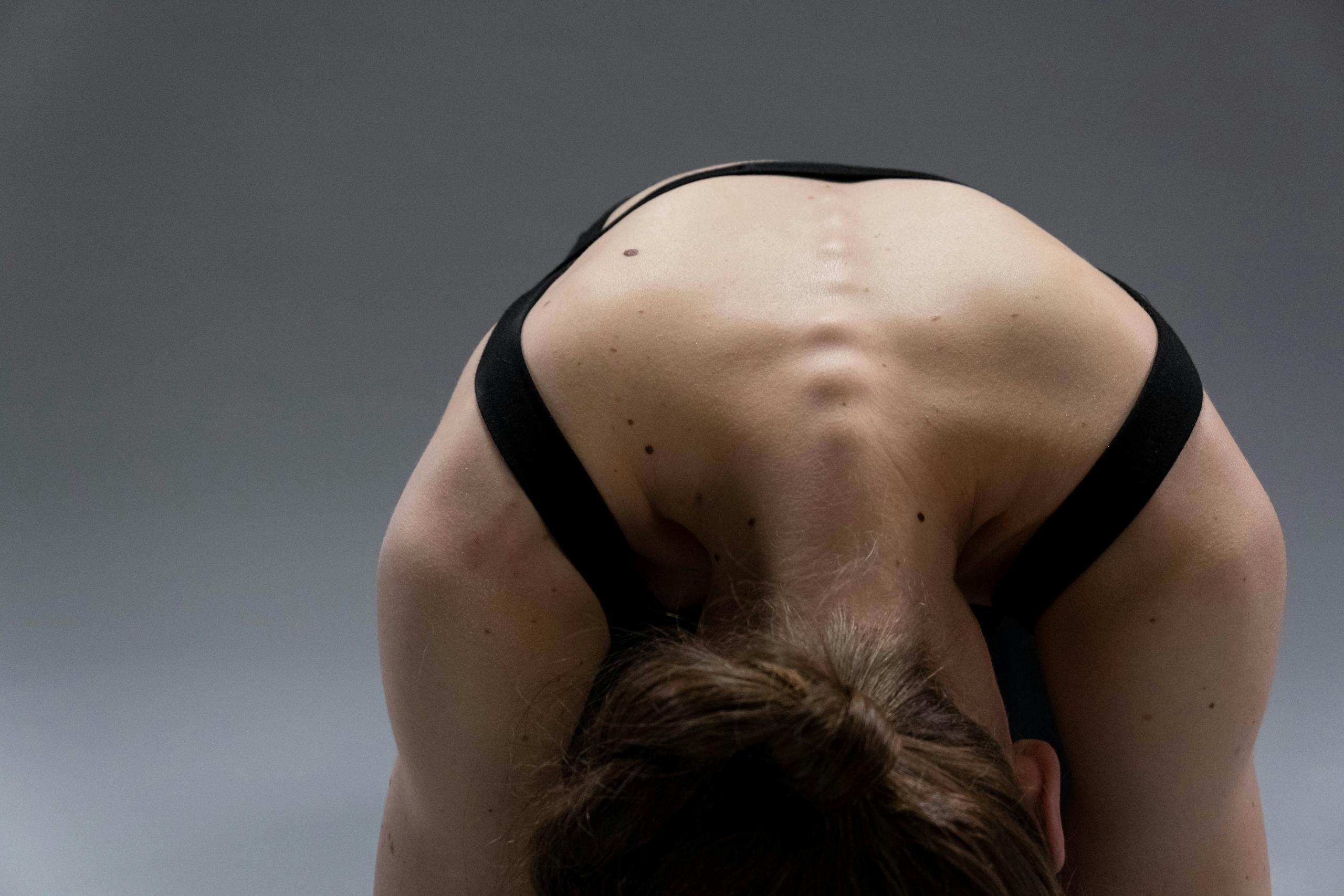How to Stop Walking Hunched Over If You Are Ages 60+
Do you find yourself walking more and more hunched over as you get older.
Or have you looked at yourself in the mirror and thought, Wait… when did my posture start looking like this?
You see as we age, our posture naturally shifts due to muscle loss, joint stiffness, and years of habits that have slowly crept up on us.
But here’s the good news: poor posture isn’t something you have to accept as a natural part of aging.
With the right exercises, simple daily adjustments, and a little awareness, you can improve your posture, walk taller, and feel stronger.
Therefore in this post we’re going to be talking about how to stop walking hunched over if you’re over the age of 55.
I going to show you how to correct and fix this with practical tips, gentle exercises, and lifestyle adjustments. We’ll also dive into why our posture changes as we age.
As such if this is your first time landing here on my blog welcome and my name is Patricia. Let’s get started
The Causes: Why Do We Start Walking Hunched Over?
Before we dive into solutions, let’s talk about why posture changes as we get older.
Now many people start to walk hunched over the older they get and though this is true there is also a big myth that this automatically happens to everyone.
A hunched-over posture doesn’t happen overnight—it’s the result of years of small changes in the body.
Here are some common reasons why people over 60 start to hunch over: There are several factors that contribute to a hunched-over stance, and these include:
✅ Muscle Stiffness and Weakness – As we age, the muscles that support our posture—especially in the back, core and shoulder—can weaken if they’re not regularly exercised.
For example tightness in the chest area like in the pectoral muscles if they become tight they can pull the shoulders close together which can then gives you that hunched appearance.
This is commonly happen to desk workers and people who do a lot of things in this kind of position.
✅ Joint Stiffness – As we age, joints lose flexibility in the spine, shoulders, and hips which as a result can make standing upright feel more difficult or uncomfortable.
For example weakness in the shoulder blade muscles namely the rhomboids and the lower trapezius muscles which are between the shoulder blades.
If they’re weak they allow the shoulder blades to split apart which then gives you a hunched over appearance.
✅ Bad Daily Postural Habits Overtime– Bad posture and bad postural habits can lead to weakness in some of your important muscles around your spin, neck and shoulders and when these muscles get weak they causes problems with posture and walking hunched over.
Years of sitting, looking down at screens, carrying heavy bags on one side or slouching while watching TV can create bad postural habits that become second nature.
Also some people just find that over time they start to find themselves feeling a bit safer when they’re closer to the ground so they start to hunch forward.
✅ Spinal Changes – Yes conditions like osteoporosis, arthritis, or degenerative disc disease can contribute to spinal curvature which can lead to a hunched over appearance, making it harder to maintain a straight posture leading to a more hunched appearance.
Even changes like spinal stiffness in the thoracic spine is a factor as people get older they can develop stiffness there and as a result they tend to loss extension and come into a natural flexed posture which we call kyphosis.
But this can be combatted with the right exercises which I’m going to show you in a minute.
✅ Lack of Awareness – Many people don’t even realize they’re hunching until they see a picture or themselves in the mirror or they feel pain and discomfort they simply don’t realize it.
The key takeaway? While aging naturally affects posture, there’s still plenty you can do to prevent and even reverse it!
4 Ways to Help Stop Walking Hunched Over
So now let’s talk about how to fix this problem. Now if you find any of the exercises I’m going to be sharing with you painful just avoid them.
This advice isn’t suitable for everyone but if you find it comfortable and you’ve had the okay from your doctor you can give these things a try.
Tight muscles of the spine, shoulders and chest can pull your body forward, making it harder to stand tall.
Adding exercise and stretches to your routine can loosen those tight areas and help realign your posture.
Now let’s have a look at what I suggest for fixing this hunch posture.
1. Strengthen Your Postural Muscles
A strong back, core, and shoulders are essential for maintaining an upright posture. Here are a few simple exercises to help:
1. Wall Angels (Postural Correction Exercise)
Muscles Targeted: Upper back, shoulders
Steps:
- Stand with your back against a wall, feet about 6 inches away from it.
- Keep your lower back, upper back, and head touching the wall.
- Raise your arms to form a 90-degree angle (like a goalpost).
- Slowly slide your arms up, then lower them back down.
- Repeat for 10-12 reps, keeping your back and head against the wall.
2. Seated Rows with Resistance Band
Muscles Targeted: Upper back, mid-back, shoulders
Steps:
- Sit on a sturdy chair or floor with legs extended.
- Loop a resistance band around your feet, holding both ends.
- Sit up straight, engage your core, and pull the band towards your body, squeezing your shoulder blades together.
- Slowly return to the starting position.
- Repeat 10-12 reps for 2-3 sets.
3. Chin Tucks (Neck Posture Correction)
Muscles Targeted: Neck, upper back
Steps:
- Sit or stand with your back straight.
- Gently pull your chin straight back, creating a double chin effect.
- Hold for 5 seconds, then relax.
- Repeat 10 times to strengthen neck alignment.
4. Standing Shoulder Blade Squeeze
Muscles Targeted: Upper back, shoulders
Steps:
- Stand tall with feet hip-width apart.
- Squeeze your shoulder blades together as if you’re holding a pencil between them.
- Hold for 5 seconds, then release.
- Repeat 10-12 times for 2-3 sets.
5. Pelvic Tilts (Core and Lower Back Strengthening)
Muscles Targeted: Lower back, abdominal muscles
Steps:
- Lie on your back with knees bent and feet flat on the floor.
- Gently tilt your pelvis backward, pressing your lower back into the floor.
- Hold for 5 seconds, then relax.
- Repeat 10-12 reps for 2-3 sets.
6. Bird Dog Exercise (Core and Back Stability)
Muscles Targeted: Lower back, core, shoulders
Steps:
- Start in a tabletop position (hands and knees on the floor).
- Extend your right arm and left leg straight out, keeping your back neutral.
- Hold for 5 seconds, then return to the starting position.
- Repeat on the other side.
- Perform 10 reps per side, 2-3 sets.
7. Bridges (Lower Back and Glute Activation)
Muscles Targeted: Glutes, core, lower back
Steps:
- Lie on your back with knees bent and feet flat on the floor.
- Press through your heels and lift your hips, forming a straight line from shoulders to knees.
- Hold for 5 seconds, then lower slowly.
- Repeat 10-12 reps for 2-3 sets.
Tips for Best Results:
- Try doing these exercises 3–4 times a week for gradual improvement , and you’ll start feeling the difference!
- Focus on slow, controlled movements to avoid injury.
- If you experience pain, stop and consult a professional.
2. Be Mindful of Your Posture Throughout the Day
Even the best exercises won’t help if you go right back to slouching throughout the day. Try these posture-friendly habits:
✔️ Stand Tall – Imagine a string pulling you up from the top of your head. This simple mental cue can instantly improve your posture.
✔️ Sit Correctly – When sitting, keep your feet flat on the floor, shoulders relaxed, and avoid hunching forward. Use a lumbar support cushion if needed.
✔️ Adjust Your Screens – If you spend time on a phone, tablet, or computer, make sure the screen is at eye level to prevent looking down for long periods.
3. Walk with Intention
When walking, focus on:
✔️Keeping your head up and looking forward (not down at the ground).
✔️Swinging your arms naturally to engage your back muscles.
✔️Taking smaller, controlled steps if you feel off balance.
A great tip? Walk as if you’re carrying a book on your head—it helps reinforce proper alignment!
4. Consider Posture Support Aids
If you need extra help retraining your posture, consider using:
A Posture Brace – Provides gentle reminders to keep your shoulders back.
Supportive Chairs or Cushions – Helps you sit properly and avoid slouching.
Massage Therapy or Chiropractic Care – Can relieve muscle tightness and improve alignment.
Final Thoughts:
If you’ve been walking hunched over, don’t worry—you can improve it!
With consistent effort, gentle exercises, and mindful habits, you’ll start standing taller, feeling stronger, and moving with more confidence.
Remember, small changes add up over time. Start today with one or two of these tips, and before you know it, you’ll notice a difference in your posture and overall well-being.
Now, I’d love to hear from you—have you struggled with posture changes as you’ve gotten older? What has helped you improve it? Let’s chat in the comments below!







